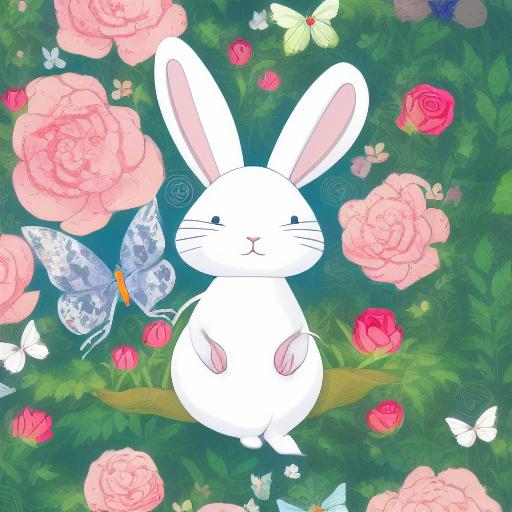How to write this prompt?
Here’s a breakdown of the different elements of the prompt and how they influence the image being generated:
- Description of the main subject: “a white rabbit sleeping in the middle of a forest”
- This sets the scene for the image and establishes the focus on the rabbit as the main subject.
- Additional elements in the setting: “with roses and butterfly”
- This provides more detail about the environment in which the rabbit is sleeping and helps to create a more vivid picture in the mind of the reader.
- Inspiration from existing artwork: “a storybook illustration by Yuko Tatsushima, shutterstock contest winner, process art”
- This provides a specific reference point for the style and tone of the image being generated, and suggests a whimsical and dreamy aesthetic.
- Setting context: “a forest with bunnies”
- This reinforces the natural setting of the image and adds to the overall mood.
- Style and tone: “illustrated in whimsical style, dreamy illustration”
- This sets the tone for the image, and guides the AI in creating a softer and more imaginative aesthetic.
Taken together, these elements work in harmony to provide a clear vision for the generated image. By including specific details and inspirations, the prompt can help to guide the AI in creating a more specific and satisfying result.
What is the significance of using process art in creating illustrations like the one by Yuko Tatsushima?
Process art is a type of art that focuses on the process of creation rather than the final product. In the context of illustration, this means emphasizing the technique and materials used to create the image rather than just the visual result. By using process art techniques, artists like Yuko Tatsushima can create more organic and unique illustrations that reflect the artist’s own personal style.
How to create a whimsical illustration style like the one in the prompt?
To create a whimsical illustration style, artists typically use a combination of soft, flowing lines and muted or pastel colors. They may also incorporate elements of fantasy or imagination into the image, such as animals with human-like qualities or surreal landscapes. Experimenting with different materials and techniques can help artists develop their own unique style that evokes a sense of whimsy.
Why is it important to include specific details when writing an AI image prompt?
Including specific details in an AI image prompt helps to guide the AI in creating a more precise and accurate image. By providing specific elements such as colors, objects, or settings, the AI can more easily understand the desired result and produce an image that closely matches the prompt. This can help to avoid ambiguity and ensure that the generated image meets the expectations of the user.
How does AI generate art?
AI generates art by using algorithms that mimic human creativity. These algorithms are trained on large datasets of existing artwork and can learn to recognize patterns, styles, and techniques that are characteristic of certain types of art. Once trained, the AI can then generate new images that incorporate these patterns and styles in unique ways.
The process of generating art using AI typically involves several steps. First, the AI is trained on a dataset of images, which it uses to learn about different styles and techniques. Next, the AI is given a prompt or input, such as a description or sketch of the desired image. The AI then uses its learned knowledge to generate a new image that matches the input in terms of style, color, composition, and other factors. Finally, the AI may refine the image through a process of trial and error, using feedback from the user to improve the result.
What types of art can be generated using AI?
AI can be used to generate a wide variety of art, including paintings, drawings, sculptures, and even music and literature. Some of the most popular applications of AI-generated art include:
- Abstract art: AI algorithms can create complex and intricate patterns and textures that are reminiscent of abstract art.
- Landscapes and cityscapes: By learning from existing images of real-world locations, AI can generate realistic and detailed landscapes and cityscapes.
- Portraits and figurative art: AI can generate images of people and animals that are highly realistic and expressive.
- Surreal and fantastical art: With its ability to combine and manipulate images in unusual ways, AI is well-suited to creating surreal and fantastical art that stretches the limits of human imagination.
- Text-based art: AI can generate poetry, prose, and other types of written art that incorporate language in unique and unexpected ways.
Overall, the range of art that can be generated using AI is limited only by the creativity and imagination of the programmers and users who work with these technologies.
Looking to add some cutting-edge creativity to your designs? Look no further than Visual Paradigm Online! With our innovative design tools, you can seamlessly incorporate stunning AI-generated art into your graphics with just a few clicks. Our user-friendly interface and extensive range of design templates and assets make experimentation a breeze, so you can explore countless styles and layouts until you find the perfect combination for your project. Elevate your designs to the next level with Visual Paradigm Online today!


